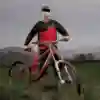Enduro is a punishing mountain bike discipline, requiring not only strength, skill and nerve, but also a huge degree of fitness and staying power. For those who don't know – MTB enduro is multi-stage racing which usually involves timed downhill runs and untimed uphills.
Ahead of the final round of the Enduro World Series (EWS) in Finale Ligure, Italy, this weekend, regular EWS racer Joe Barnes tells you how to train for enduro. Here are some nuggets of wisdom he imparted on how to build your enduro fitness and technique.
1. Ride your race bike all year
The beauty of enduro is that one bike does it all and Joe extends this to his year-round training. With only one practice lap at races and ever-changing conditions, the one constant will be your bike. Make yourself completely familiar with it until you feel at home in the saddle and you'll have one variable fewer to contend with. If you train on another bike, road or mountain, a little part of your brain will constantly be concentrating on the riding. Train and race on one and it will be second nature, so you can fully focus on the course.
I even have a replica of my race bike on the turbo trainer, so I can do interval training with all the same angles and fit
You might not be able to take it to that extreme, but you get the point!
2. Experiment with your nutrition
It's worth experimenting with food to see what agrees with your system and what doesn’t – it can have a huge impact on your performance come race day. Once you have that knowledge in place, stick to it, don’t be tempted by that pre-race curry binge if you know you perform best on something else the night before.
For me, dinner the night before a race is always mashed potatoes, fish and vegetables – I always feel bad after big pasta blowouts. If the Canyon team decide to eat out the night before, I always do my own thing. Breakfast on the day is uncooked porridge and fruit, with peanut butter and jam sandwiches for mid-event nutrition
It sounds simple but it works and as Joe is at pains to point out, race week is never the time to be experimenting with diet. Stick to what you know.
3. Start a training diary
"Measuring the gains is as important as making the gains,” says Joe and the only way to do that is to note your training on a daily basis.
Not only does filling out a training diary help with keeping notes to see how you're progressing and identifying where problems and weaknesses might be lurking in your game, it's also hugely satisfying to fill out daily.
4. Invest in a turbo trainer
“The only really reliable way to measure performance is using power cranks and they aren’t too expensive these days. They are well worth investing in and are a massive training aid.” says Joe.
Choose a 10-minute climb every so often and hit it hard to see just how your average power and endurance have improved over the same ground. Turbo trainers are useful for this, but make sure you get one that uses magnets rather than fans to provide resistance – that way your output isn’t affected by changes in air pressure.
You can also use the diary to note things like sore shoulders or tight hamstrings – it's always easier to tailor your program if you remember to include injuries in your plans.
5. Try strength training at the gym
While they form the cornerstone of your training diary, it’s not all about long rides and intervals to build your fitness and strength. Going to the gym is also hugely important to cover those areas not always worked just by riding the bike. Training for strength and power in the gym is all important to give you an edge.
“Arm fatigue is one of the biggest factors that slow people down at enduros,” Joe is keen to point out, “not lungs or legs, and the gym is the best way to combat this.”
He regularly uses finger boards designed for indoor climbing and swears by the ‘farmers walk’ exercise with weights – where you pick up heavy weights and work your grip by walking in circles. It helps that all-important grip strength and endurance.
6. Rest
According to Joe this is the most important part of your diary.
“I work to the theory that three days of exercise will require one day of rest and I always rest the day after a race – as much for relief from the mental stress of racing as anything else.”
Of course this can change depending on the time of year, but training without adequate rest just runs you down and, as Joe says, most exercises need maximum effort put in to do any good. Any less and you are wasting your time. If in doubt err on the side of resting.





